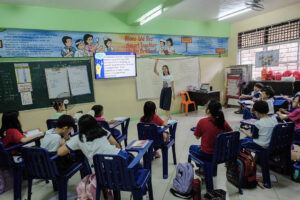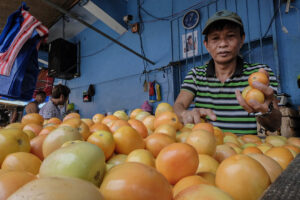The 1987 Constitution is pernicious for many reasons. Its Filipino First and Filipino Only provisions promoted concentration in the economy (monopolies and oligopolies) due to a lack of foreign competition. Its political model produced family dynasties and a ludicrous party-list system.
However, its emphasis on “social justice” through asset reform is just as pernicious. The Constitution broadly calls for regulating “the acquisition, ownership, use, and disposition of property and its increments.” (Section 1, Article XIII). For farmers specifically, the Constitution calls for redistributive justice through an agrarian reform program (Section 4, Article XIII.)
In line with the 1987 Constitution, the Comprehensive Agrarian Reform Law (CARL) was passed in 1988. What has been the effect of that law? According to international economists Tasso Adamopoulos and Diego Restuccia, who wrote for the prestigious National Bureau of Economic Research, CARL reduced average land size by 34% and agricultural productivity by 17%. In other words, farmers became poorer. As National Scientist Dr. Raul Fabella describes the outcome of land reform, landless farmers became “impoverished landlords.”
The problem of social justice through asset reform is that it is zero-sum, i.e., the gain of some is a loss to others. The land to the landless is a loss to the landlord. Asset reform, therefore, creates uncertainty in property rights, dampening investment in agriculture.
The Filipino First and Filipino Only provisions and the asset reform aspects in the Constitution are understandable because the forces that deposed Marcos Sr. represented the anti-Marcos oligarchy, the Catholic Church, and leftist elements in society.
We must move away from the Yellow-leftist principles of the 1987 Constitution, which, after 47 years, had only given us a weak and corrupt state, impoverished farmers and low agricultural productivity, high inequality, an uncompetitive economy, and a political system dominated by dynasties.
For social justice, I propose not asset reform but education as the equalizing reform. As I keep repeating, education is the only good that, when given, enhances the giver. It’s not zero-sum. When I teach somebody economics, for example, I can converse with him/her. I can learn as much as I teach. Education is a win-win.
Because education is a win-win, unlike asset reform, the ruling class will embrace it rather than resist it.
Education is lifelong. Unlike an asset, like land, which the recipient can dissipate, education doesn’t depreciate or become mishandled. When somebody learns how to read and write, that’s forever until that person dies.
Education is also portable. It’s one thing that even refugees can bring with them. Perhaps for this reason, Jews, historically persecuted and exiled, emphasize education. Ironically, Palestinians also emphasize education, with their literacy rate among the highest in the Arab world. Our OFWs know that they bring only education and know-how when they move to other countries. Unfortunately, because Philippine education has been deteriorating, many of our OFWs work presently as domestic helpers or low-paid workers.
Most of all, education is essential for inclusive economic growth. Higher productivity and, therefore, higher-paying jobs require education, which is significantly truer now in the age of robotics and artificial intelligence. Physical labor won’t be enough to operate machines or computers. Lack of education condemns people to poverty or low-end jobs.
This is why the parlous state of Philippine education is so concerning. Our economy, based on a Filipino First and social justice mentality, did not emphasize education. The state of Philippine education is so bad it can make one cry. According to the World Bank, our learning poverty rate is 90%. This means 90% of our 10-year-olds cannot grasp age-appropriate text and concepts. The Philippines ranks near the bottom of the PISA (Programme for International Student Assessment) tests given to 15-year-olds for reading, science, and mathematics among 81 countries.
EDCOM Executive Director Karl Yee also paints a grim picture of the state of Philippine education. He says the learning gap of students is about 5.5 years. Grade 8 students struggle with basic concepts of multiplication and subtraction.
Therefore, the sad state of Philippine education poses a massive problem for the Philippine economy. It might be a big reason investors are skipping the Philippines for Vietnam, which ranks second just behind Singapore in science, mathematics, and reading. Today’s computer-controlled machines require more than muscles and a grade school education.
The country’s ambition to reach middle-income status is threatened by the poor quality of its human capital. Because of its relatively young population, the country can reap the so-called “demographic dividend,” or economic growth powered by a low dependency ratio and an expanding workforce. However, that opportunity may be an affliction if our young, uneducated workforce cannot find good jobs. Bereft of upward social mobility, they may become criminals or sociopaths. Inequality will soar, and social tensions increase.
However, populism, statism, protectionism, and leftism continue to animate discussions on equalizing reforms and reducing inequality: more social welfare payments and higher protection for farmers, higher minimum wages and more holidays for workers, more land to the landless, import quotas and restrictive land conversions to protect farmers, and more money for the education bureaucracy. These ideas have not lifted people out of poverty.
How can education in the country be improved? We must move away from the principles of leftism, economic nationalism, protectionism, statism, and asset reform enshrined in the 1987 Constitution. Agricultural protectionism, for example, has led to high food prices and severe nutritional deficiency among our youth. Malnutrition in the first 1,000 days of babies’ lives impairs their ability to learn later in life. High corn prices mean high chicken and pork prices, translating to protein deficiency, especially among adolescents. No wonder the average height of Filipino women is shrinking. (Nababansot, in the vernacular.)
Asset reform has led to land fragmentation, low productivity, and high food prices. Reversing land fragmentation through farm consolidation and increasing land retention limits is the first step in reforming Philippine education.
The statism enshrined in the Constitution has led to a boondoggle of an education bureaucracy. According to educator and management expert Dr. Victor Limlingan, the Education department has one million employees on its payroll and 12 levels of administrative bureaucracy between the Secretary of Education and the classroom teacher. It’s too bureaucratic. Dr. Limlingan suggests a phased and planned devolution of primary and secondary education to Local Government Units and local school districts.
Furthermore, since the government is inefficient and incapable of providing quality education, it should consider expanding school vouchers to the primary and junior high school levels. Studies have shown that students who graduate from private schools score at par with those from countries with similar levels of GDP per capita. In other words, the performance of public-school students is pulling down the Philippine average. Private schools produce better graduates and are far more efficient than public schools. Therefore, the government should expand the school voucher system.
Other issues must also be addressed, including curriculum reform (too much time for sibika and insufficient learning time mastering the basics of reading and math), insufficient qualified math and science teachers, and the system of mass promotion.
To sum up, as a society, we must start focusing on education as the equalizing reform and bury the ideas of asset reform, “land to the landless,” protectionism, and ayuda as social justice. Otherwise, we can’t sustain economic growth and will just redistribute poverty.
Calixto V. Chikiamco is a member of the board of IDEA (Institute for Development and Econometric Analysis).















